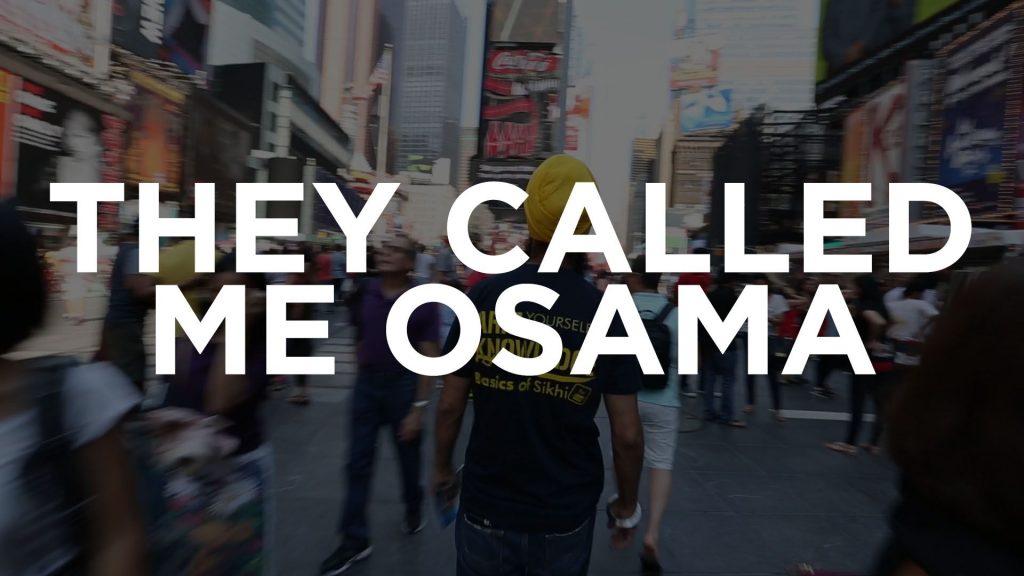
by Nehal Mehra
Maneetpaul Singh, a 22-year-old University of Connecticut graduate and producer of the short documentary film, “They Called Me Osama,” shares his views about the presence of Sikhism in the U.S. and the power of film.
“When someone sees and hears firsthand accounts of people who have experienced hate crimes, it really resonates with them,” Singh said. “In addition to this, it allows them to visually see that we are no different than any other American. Sometimes this is the best way to get people to change their own opinion, or at the very least spark an interest for them to learn more.”
A strong contender on the top of his goals list, Singh said he could not have asked for a better opportunity to accomplish his goal of producing a film, that too about Sikhism.
“I’ve always been interested in making films,” he said. “It’s something about being able to record what’s in front of you and being able to turn that into a story people will find entertaining that I really love. In regards to filmmaking, my goal has always been to make a short film about Sikhi. When the IDEA grant opportunity was presented to me at UConn, I knew this was my chance to do that. I hope to continue doing this into the future with more projects.”
“They Called Me Osama” is a documentary produced to uncover the trials and tribulations of Sikhs in America. From prominent industry professionals like Columbia University professor Prabhjot Singh who spoke about his experience being attacked three years ago while being called “Osama” and “terrorist,” to elementary school children, the film exhibits the ignorance and hate crimes endured by the community.
Their way of retaliation? Love and education; combatting hate crimes with endearing messages and equipping fellow Americans with the right knowledge about Sikhism to understand who they are as people.
Singh culturally conditioned, like many of us, followed Sikhism as his immediate and extended family were practicing Sikhs. It was only in his teenage years when he said he began his journey of questioning his religious identity.
“I never really understood Sikhi until I took the time to research it on my own,” he said. ” Especially when I came across channels like Basics of Sikhi on YouTube. It just motivated me to keep learning our history and spreading that knowledge with other Sikhs. Many of us wear turbans and keep a Sikh identity, but since we grew up in America, we don’t know the history behind it or the ‘why’ to the many things we do as Sikhs.”
The same inquisitive nature and faith in his belonging motivated Singh to partner with British YouTuber Jagraj Singh, an educator from Basics of Sikhi, in the content creation of the documentary. The duo took the streets of Manhattan to enlighten their fellow Americans about Sikhism and its fundamental principles.
“Manhattan is such a diverse place to be,” he said. “Everyone we spoke with was very nice and open to learning, [assuming they took the time to speak with us]. And of course, there were many who were busy and simply walked right by us. Doing street interviews like that requires very thick skin, and Jagraj Singh definitely has experience with it.”
Although the team was successful in taking steps forward in eradicating ignorance towards Sikhism, Maneet mentioned, “[the current political race] is beginning to shed a light on how some Americas really feel.”
With any project there are challenges, Singh said his hurdle was to draw a connecting string through the multiple pieces and offer an educational outlet.
“When I first started filming, I knew who I wanted to speak with, and what information needed to be in the final film,” he said. “However, it is really difficult to have such complex and emotional stories and display them in a way where it becomes educational.”
Maneet’s belief in the power of film and the message it can convey is evident in his production. This young Sikh’s drive is apparent in his continuous efforts and planned endeavors in his community.
“Currently, I am working on a lot of smaller projects that are local to our community in the tristate area. In addition to this, I am really involved with local camps such as Camp Chardi Kala, and spend a lot of time doing video and digital media work for them. The best way to make a large impact is by working with local communities and growing from there.”
 Nehal Mehra, a graduate student from New York University, is a native Torontonian currently residing in the Big Apple. She finds solace in the arts, beauty and all you can eat sushi. If you can’t find her scrolling her social media feed or studying at a Starbucks, look in the aisles of Sephora or blasting Bollywood tunes in her bedroom.
Nehal Mehra, a graduate student from New York University, is a native Torontonian currently residing in the Big Apple. She finds solace in the arts, beauty and all you can eat sushi. If you can’t find her scrolling her social media feed or studying at a Starbucks, look in the aisles of Sephora or blasting Bollywood tunes in her bedroom.




